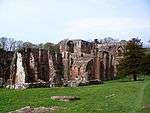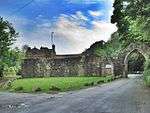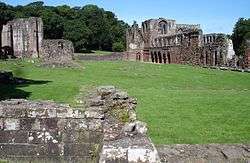Furness Abbey
|
The abbey in August 2007 | |
| Monastery information | |
|---|---|
| Full name | Furness Abbey |
| Other names | St. Mary of Furness |
| Order | Cistercian |
| Established | 1123 |
| Disestablished | 1537 |
| Mother house | Congregation of Savigny |
| Controlled churches |
Byland Abbey Calder Abbey Inch Abbey Rushen Abbey Swineshead Abbey |
| People | |
| Founder(s) | Stephen, Count of Blois |
| Site | |
| Location |
The Vale of Nightshade, Newbarns, Barrow-in-Furness, Cumbria, England |
| Public access |
Yes ( |
Furness Abbey, or St. Mary of Furness is a former monastery located in the northern outskirts of Barrow-in-Furness, Cumbria, England. The abbey dates back to 1123 and was once the second wealthiest and most powerful Cistercian monastery in the country, behind only Fountains Abbey in North Yorkshire.[2]
History of the abbey
Early history

Founded in 1123 by Stephen, Count of Boulogne,[1] it was built originally for the Order of Savigny.[3] Located in the 'Vale of Nightshade', south of Dalton-in-Furness, the abbey is built entirely out of local sandstone. It passed in 1147 to the Cistercians, who gradually enlarged and rebuilt the original ornate church. The majority of the current ruins date from the 12th and 13th centuries. By the 15th century, it had been completely re-modelled and had become the second richest and most powerful - as well as one of the grandest - Cistercian Abbeys in England, behind Fountains Abbey.[2] The gothic-style monastery and its adjacent structures cover an expansive area of land and reach a maximum height of 40 metres (131 ft) above ground level.[4]
The monks of the abbey were large landowners, and the most powerful body in what was then a remote border territory. In particular, they were heavily influential on the Isle of Man. One of the kings of Mann and the Isles is buried at the abbey, as are many of the Bishops of Sodor and Man. Rushen Abbey on the Isle was built on land owned by the monks.[5] They also owned mines on the island, and built Piel Castle to control trade between the Furness Peninsula and the Isle of Man. Being about 70 miles down the coast from Scotland, the monks occasionally found themselves in between the regularly warring Scots and English. When Robert the Bruce invaded England, during The Great Raid of 1322, the abbot paid to lodge and support him, rather than risk losing the wealth and power of the abbey.
The Abbey was disestablished and destroyed in 1537 during the English Reformation under the order of Henry VIII.
Late history

It now lies in ruins and is a popular tourist attraction, lying on the Cistercian Way — an ancient walk popular with tourists, which used to link the Abbey with the nearby town of Dalton-in-Furness. William Wordsworth visited on a number of occasions and referred to it in his famous 1805 autobiographical poem The Prelude, whilst Turner made numerous etchings of the Abbey. Other notable tourists include the Theodore Roosevelt family. It was the first unguided visit on their European tour. A young Teddy Roosevelt and his siblings played on the ruins, which, in 1869, were not roped off or restricted.[6]
Conservation and protection
The Furness Abbey complex is a Scheduled Monument and Conservation Area containing five Grade I listed buildings and structures. Restoration work has been ongoing since 2010 amid fears that part of the abbey could collapse.[7]
Folklore and supernatural activity

There are also many stories and sightings claiming that Furness Abbey is haunted, there are at least three ghosts which have supposedly been seen numerous times at the Abbey. Firstly, it is purported that the spirit of a monk has been seen climbing a staircase and also possibly walking towards the gatehouse before vanishing into a wall.[8] Another sighting is that of a squire's daughter. She was known for meeting her lover at the ruined abbey after the Reformation, although one day her partner took a journey out to sea from which he never returned.[8] It is thought that the girl went back to the Abbey every day until her death to take in the site she and her partner once loved, the track she walked is today still known as "My Lady's Walk."[8] There have also been many sightings of a white lady, although due to possible conflicting stories, it is unknown whether the White lady and the ghost of the squire's daughter are the same person or not. Possibly the most famous ghost of Furness Abbey is a headless monk on horseback, who rides underneath the sandstone arch near the Abbey Tavern, this death of this individual is linked to an invasion by the Scots in 1316.[8]
A tunnel has been said to run underneath the Abbey to both Piel Castle and Dalton Castle allowing the monks to receive supplies and keep watch upon the local settlements. It has also been rumoured that the Holy Grail and King John's missing jewels, are actually hidden somewhere inside the 'Ley tunnel'.[9]
Mystery plays
Furness Abbey has hosted a number of large scale mystery plays. The first to take place were over several consecutive nights in 1958 and saw Prince Edward attend.[10][11] The mystery plays continued throughout the 1960s until the recruitment of the approximate 100 plus participants became difficult. Renowned author Melvyn Bragg was in attendance of the 1988 mystery plays revival, which were the last such performance at the abbey.[11]
Access and facilities
Furness Abbey is located off Manor Road close to Barrow's main thoroughfare, Abbey Road, which is named after the Abbey itself. The Abbey also lies next to the Furness Line and was served by Furness Abbey railway station until closure in 1950. The closest stations are now Roose and Dalton.
English Heritage operates a small visitor centre at Furness Abbey which includes a number of stone carvings and effigies as well as a gift shop. It, alongside the abbey is open to the public between 10am and 6pm daily. Free passes are available for English Heritage members as well as local residents, while standard visitor entry stands at under £5 per person.
Burials
- William Russell, former Bishop of Mann and the Isles
- Rǫgnvaldr Guðrøðarson
Gallery
 Detail of some of the abbey's arch ways
Detail of some of the abbey's arch ways Ruined pillars within the abbey
Ruined pillars within the abbey Looking towards the former bell tower
Looking towards the former bell tower Another section of the abbey
Another section of the abbey The abbey viewed from the south-east
The abbey viewed from the south-east Ruins of separate outbuildings
Ruins of separate outbuildings Former gateway to the abbey
Former gateway to the abbey_(cropped).jpg) Grave cover on display in the visitor centre
Grave cover on display in the visitor centre 1888 depiction of the abbey prior to destruction
1888 depiction of the abbey prior to destruction 1778 print of the abbey
1778 print of the abbey Painting of the abbey by Edward Dayes
Painting of the abbey by Edward Dayes 1412 manuscript relating to the abbey
1412 manuscript relating to the abbey Furness Abbey by Henry Fox Talbot, circa 1853/58
Furness Abbey by Henry Fox Talbot, circa 1853/58
See also
- List of monasteries dissolved by Henry VIII of England
- Listed buildings in Barrow-in-Furness
- Ley tunnel
- Abbot's Wood, Cumbria
Further reading
- Atkinson, Rev. J.C., The Coucher Book of Furness Abbey, Printed from the Original Preserved in the Record Office, London, Part 1, London, 1886
References
| Wikimedia Commons has media related to Furness Abbey. |
- 1 2 Furness Abbey (Visitor Information), English Heritage.
- 1 2 History of the abbey
- ↑ Furness Abbey - Catholic Encyclopedia article
- ↑ Skyscraper News Furness Abbey
- ↑ Rushen Abbey, Isle of Man, Ingram Consultancy
- ↑ David McCullough, Mornings on Horseback (NY: Simon & Schuster, 1981), 76-8
- ↑ Collapse fears at Furness Abbey North West Evening Mail, 14 December 2009
- 1 2 3 4 "Ghostly Cumbria". The History Press. 2014. Retrieved 7 March 2015.
- ↑ "Official Guide and Street Plan" (PDF). Barrow Borough Council. Retrieved 7 March 2015.
- ↑ Furness Abbey Mystery Plays
- 1 2 Furness Abbey Visitors
Coordinates: 54°8′7″N 3°11′52″W / 54.13528°N 3.19778°W
External links
- Information for teachers: English Heritage
- Risk assessment information for teachers: English Heritage
